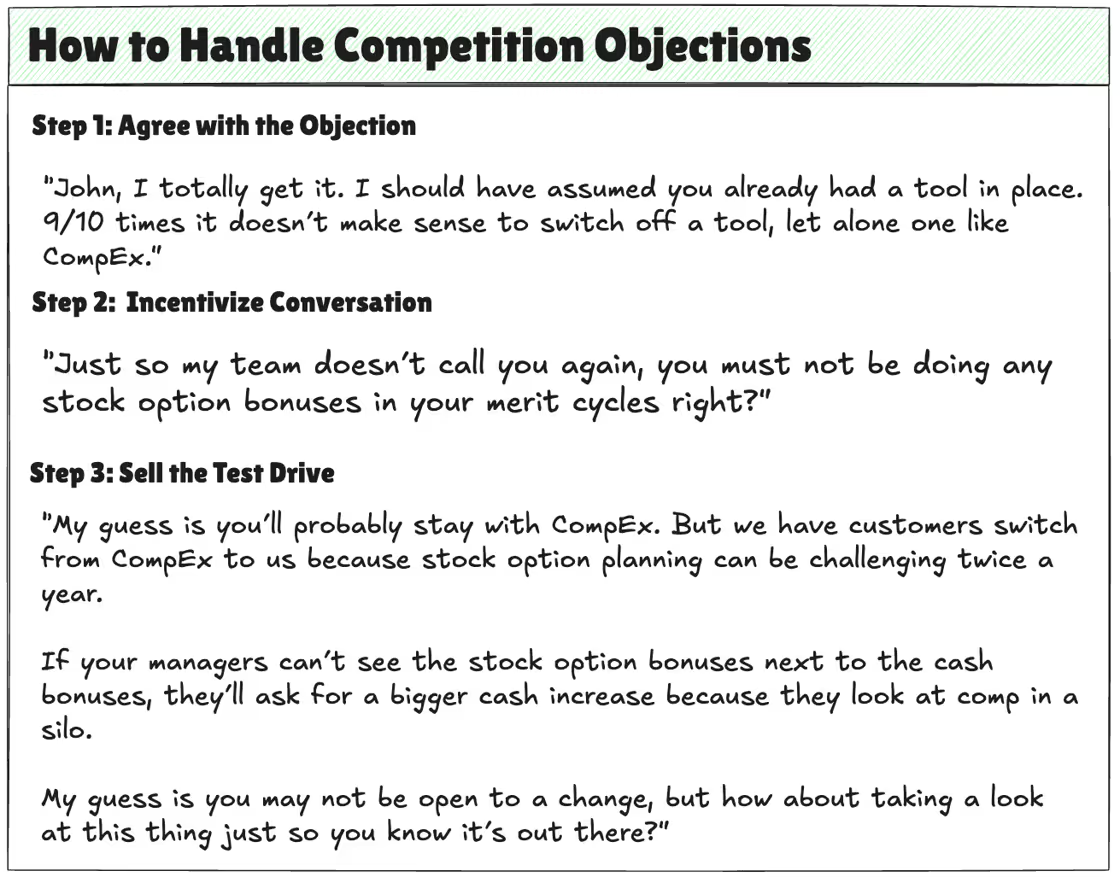It’s end of month — you either schedule one more meeting or miss quota.
You’re frantically dialing.
Finally: “Hello, this is John.”
You nail the opener. But he replies:
“We’re all set, Acme Co already helps us with that.”
You blurt out 18 reasons why Acme Co sucks. Then John hangs up.
The absolute worst way to handle competition objections is to list off everything wrong with them and why your product is better.
9/10 times your buyer brought them in, so they’re going to get defensive.
Plus you’re playing for the other team, why the heck would they listen to you?
Instead, ask questions that get the prospect to realize the competitor’s holes themselves.
Today we’ll break down my three step play to handle any competition objection:
- Agree with the Objection
- Incentivize Conversation (+ Trap Question)
- Sell the Test Drive
Let’s get right into it.
Step 1: Agree with the Objection
Never trash your competition after a prospect brings them up on a cold call.
The second you bash the competitor, you lose them.
Remember you’re a direct competitor and calling their baby ugly because they likely brought the tool in.
Instead, just agree with the objection.
It completely disarms them because you instantly remove all sales pressure.
Here’s how I’d respond at Pave when clients said they worked with our competitor CompEx:
Armand: “John, I totally get it. I should have assumed you already had a tool in place. 9/10 times it doesn’t make sense to switch off a tool, let alone one like CompEx.”
Now they’re thinking, “Wait, this guy isn’t pitching me?”
That pattern-break catches their curiosity and makes them more open to an actual conversation.
Step 2: Incentivize Conversation (+ Trap Question)
Ask a trap question to keep the conversation going.
Trap questions force the buyer to realize the competitor’s flaws themselves — instead of getting defensive when you say it.
The key with trap questions is to know what your competitor can’t do.
For example, when I was at Pave, we knew that CompEx didn’t help with stock option planning.
So if a prospect used CompEx, I’d ask a question on stock options knowing it was a hole in their existing solution.
After agreeing with the objection, here’s how to incentivize conversation with a trap question:
Armand: “Just so my team doesn’t call you again, you must not be doing any stock option bonuses in your merit cycles, right?”
John: “We are, why do you ask?”
Notice two things here:
- I gave them a reason to answer: Nobody wants more cold calls.
- I planted doubt in CompEx: The prospect is thinking about how CompEx can’t help with stock options.
Pro Tip: Memorize 1 trap question per competitor. If you have a lot of competitors, bucket them (ie: legacy players who don’t integrate with other systems, new players with poor support, etc.)
Step 3: Sell the Test Drive
This is where most reps blow it — they start pitching.
If you start pitching here, you’ll just reapply the sale pressure and they’ll turn you down.
Instead, you need to give them a good reason to take the meeting, even if they never buy.
Not everyone wants to buy a Tesla. But a lot of people will take a test drive.
And once they’re in the car (aka meeting)… that’s when we’ll have an actual sales conversation.
Here’s exactly how I sell the test drive:
Armand: “My guess is you’ll probably stay with CompEx. But we have customers switch from CompEx to us because stock option planning can be challenging twice a year.
If your managers can’t see the stock option bonuses next to the cash bonuses, they’ll ask for a bigger cash increase because they look at comp in a silo.
My guess is you may not be open to a change, but how about taking a look at this thing just so you know it’s out there?”
Notice two things:
- Educate The Gap: I educated them on why CompEx’s functionality gap was a problem.
- Sell The Test Drive: Therefore they’ll wanna “take a look” to know what they might be missing out on (even if they never buy the product).
To be clear… this is not about setting unqualified meetings.
Once they’re in the car (and not on a cold call), they’ll be far more open to an actual conversation where you can run discovery, uncover problems, and sell the actual product.
And that’s a wrap, folks! Here's the full talk track:

Now the tone really matters with objections.
So listen to the voiceover (plus 2 more examples) in this video.
If you like what you saw, it’d mean the world if you’d like & subscribe to the YouTube channel.

















